Planting the rainbow: Garden-based education in the ‘Salad Bowl’
“I’m a scientist!” the elementary school students exclaim, flanked by the greenery of the Blooming Classroom as they triumphantly wave their science worksheets above their heads. These students are beneficiaries of the innovative partnership between nonprofit Life Lab and their local school district, which connects students with science, nutrition and nature in the garden.
“Seeing the joyful engagement of thousands of students and the positive impacts on their learning, well-being and more confirms what decades of research have shown — garden classrooms are effective, vital spaces where educators bring learning to life,” says Life Lab Co-Executive Director Judit Camacho.

Happy student showing off chard roots, stems and leaves at a Pajaro Valley, California elementary school. Photo courtesy of Life Lab.
Life Lab has been cultivating children’s love of learning, healthy food, and nature through garden-based education since 1979. They’ve done so through a variety of programs — leading children on field trips to gardens, hosting garden-based camps, designing scientific curricula for use in the garden, and producing publications, workshops, and more. But their partnership with Pajaro Valley Unified School District (PVUSD) is something new.
“It’s all about place,” explains Camacho. Located in California’s Monterey Bay region, the students of PVUSD are growing up in the “salad bowl of the world,” a fertile agricultural region where close to half of the strawberries in the U.S. are grown. “Who grows these strawberries? Who cultivates them? Who are the farmers and the farmworkers?” Camacho asks. “This is a community that is feeding us, but the same community often does not have access to those foods.”
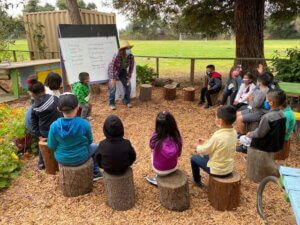
Class time in the outdoor garden classroom at PVUSD’s Amesti Elementary School in Watsonville, CA. Photo courtesy of Life Lab.
With close to 20,000 students, PVUSD is the largest school district in Santa Cruz County. More than 80 percent of the students are Latinx students, many of whom come from the community of farmworkers that cultivate the land and produce food for the rest of the country.
Almost half of PVUSD’s students are English language learners (ELLs), meaning that they did not learn English as their first language. “We know that these outdoor spaces are particularly valuable for English language learners and for children with a wide array of learning styles,” says Camacho. “We are thrilled to scale these opportunities to all of PVUSD’s elementary school students.”
PVUSD and Life Lab have partnered under the shared goal of bringing garden-based education to all 16 of PVUSD’s elementary schools by 2024. Life Lab staff are already in ten of the schools, each of which has one full-time garden instructor, with additional science instruction for grades K-2. “It’s best to learn outdoors,” Camacho declares. “Our minds capture things best when we are using all our senses, when we can see the web of life and how we are connected to the earth.”
Life Lab’s programming at the schools includes garden workdays, outdoor activities, hands-on cooking classes, and field trips to a nearby farm. They also host special outdoors science classes incorporating Life Lab’s unique environmental literacy curriculum, which integrates Next Generation Science Standards (NGSS) into garden-based education.

Students investigate a vermicompost (worm compost) pile. Photo courtesy of Life Lab.
“We want students to see themselves as scientists,” Camacho says. “We aim to plant those seeds of curiosity and wonder.” Camacho believes that teaching students the scientific method will help them to look at data and make informed decisions about themselves and their communities later in life, an important advocacy tool for young people, especially those confronting the systemic barriers that often face farmworker communities.
In addition to promoting science literacy, their “NGSS in the Garden” curriculum weaves together agriculture and environmental literacy. And to further the agricultural education of second graders, the students experience a culminating field trip to the Blooming Classroom, a three-acre farm in nearby Watsonville where opportunities for outdoor learning abound and fresh fruits and vegetables are plentiful.
John Fisher, Life Lab’s Director of Programs and Partnerships, points to the powerful effect that growing food can have on young children. “Students get to experience fruits and vegetables in a positive environment. They’re trying things for the first time and getting excited about fresh food. Parents will come to us and say, ‘I can’t believe my kid wants to eat beets!’”
Camacho adds, “It’s one thing to talk about eating a rainbow — it’s another to be planting the rainbow, tending and harvesting the rainbow, and your body lighting up from that rainbow.”
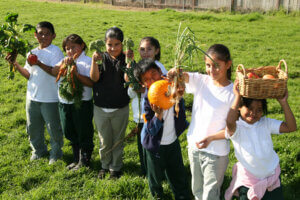
Students from PVUSD’s Hall District Elementary School show off some of the fall harvest bounty. Photo courtesy of Life Lab.
The appeal of fresh produce — and the powerhouse that is the Life Lab-PVUSD partnership — has brought another dream to fruition: a state-of-the-art new culinary garden and teaching kitchen. The project is taking shape at PVUSD’s Starlight Elementary School, thanks to a $500,000 grant from the Emeril Lagasse Foundation. Slated to open this November 2022, the site will be “the ‘north star’ of what school gardens could be,” Camacho explains. It features an 8,000 square foot garden with an adjoining 1,500 square foot 30-student learning kitchen. Cameras mounted in the kitchen will record instructors and share their lessons with the rest of the district. “This school garden will be a hub not just for the school, but for the whole community.”
Fisher adds, “Starlight Elementary currently has the smallest school garden space. They’ve been using this same space for the past 15 years.” Beyond needing a garden refresh, Starlight Elementary School is uniquely positioned to host a large school garden and kitchen: its students go on to attend Cesar E. Chavez Middle School, which boasts an extensive garden, a cooking club, and a special track for food and nutrition. Starlight is also located next door to Tierras Milperas, one of the largest community gardens in Watsonville.
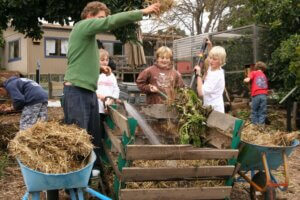
Building muscles while building compost. Photo courtesy of Life Lab.
Starlight Elementary School’s principal Jackie Medina has already begun the process of community engagement to ensure that the garden is thoughtfully designed with community input. “She’s asking community members, ‘What do you want to see in this garden? Why is this garden important to the community?’” Camacho says. “School gardens can be a place of learning and connection with the entire community.”
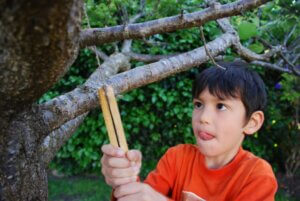
Pruning a tree branch with a hand saw. Photo courtesy of Life Lab.
Camacho shares a recent story of a student who participated in Safe Spaces, the Life Lab school program that served children during PVUSD’s COVID shutdowns. The students had just completed an art activity in the garden, but one student wanted to return to the garden to deliver a note they had written. The note read, “Hi Garden – when I’m mad or sad, to be here makes me good.”
Camacho has a lot of empathy for the students of PVUSD; she was a child of farmworker parents and an ELL student herself. Farmwork can be difficult: unrewarding and physically grueling. Learning English in the U.S. is often similarly challenging — laden with slog and stigma, sparse in glory. For these students, the opportunity to connect with nature and agriculture in a positive way helps to break cycles of intergenerational trauma, offering an outlet for healing and reestablishing healthy relationships with food and nature. Camacho sees the significance of this connection, saying, “I am deeply grateful that Pajaro Valley students will have the joyful and healing learning environments that they deserve” in their schools.
Returning to the story of the student with the note, Camacho explains, “Now, that student has a direct relationship with the garden. The garden becomes a teacher. The students learn that nature is a being, a living being — and that being in nature is good for us.” She muses, “We are recognizing that we all need more time in the natural world.”
4 Comments
Submit a Comment
-
Feature
GROWING POWER: Urban Roots connects young people with natural spaces, food systems – and one another
-
Feature
Nature photographer Dudley Edmondson has a vision for the representation of Black and Brown faces in the outdoors
-
Network News
Community Spotlight: Prescribe Outside
-
Richard Louv
SPRING FORWARD! 12 Ways to Make Sure Your Kids (and You) Get the Right Dose of VITAMIN N this Spring — and Summer, Too
-
Voices
Placemaking: How to build kinship and inclusive park spaces for children with disabilities


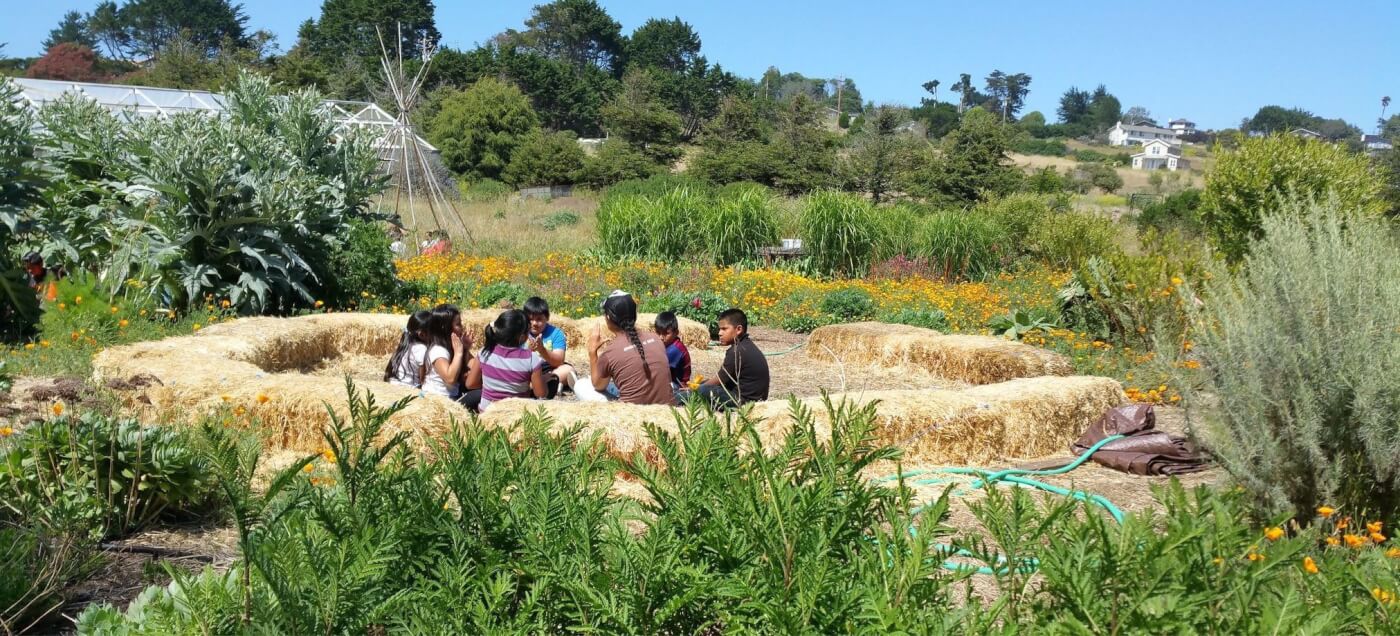

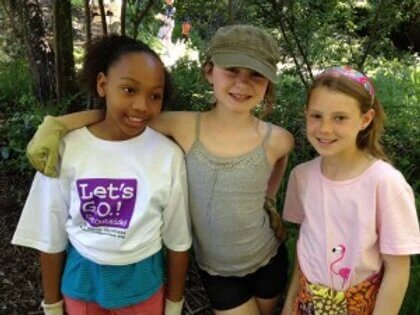
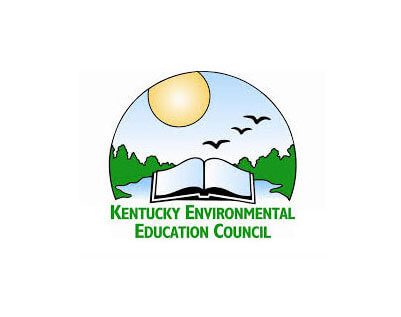
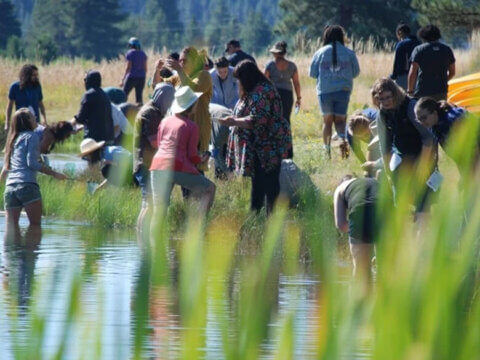
I absolutely loved this article. Extremely inspiring. These environments are also ideal spaces for planting the seeds of other kinds of literacy. For example, haiku is a kind of poetry that involves all our senses to slow down and find bits of magic in things we experience everyday. It’s poetic mindfulness. The haiku community is global and diverse. I hope you will check out the array of marvelous haiku picture books available, including my late mother Sydell Rosenberg’s 2018 H Is For Haiku (Penny Candy Books; I wrote the introduction). It was honored in 2019 by the National Council for Teachers of English.
Thanks again for highlighting this magnificent initiative!
Thanks, Amy, for this comment and for highlighting the literacy benefits of outdoor learning environments. Thanks, too, for sharing information about your mother’s book, “H is for Haiku.” What a special legacy!
What an inspiring story–garden classrooms should be everywhere! It seems that half the battle is simply making a school community aware of the possibility. Articles like this one are so important. Will share it with friends and family!
We agree and we’re thrilled that you like this story. Thank you for sharing it!